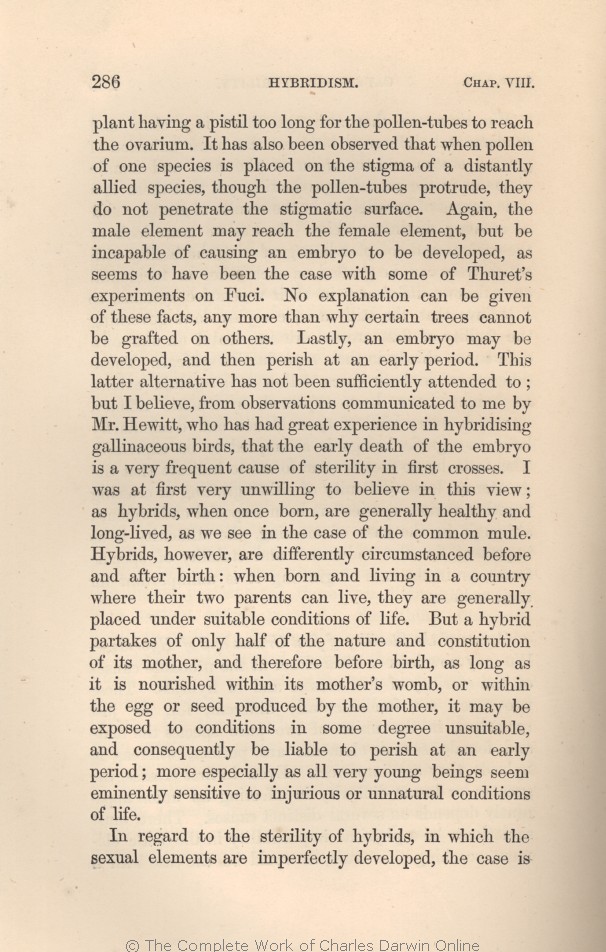plant having a pistil too long for the pollen-tubes to reach the ovarium. It has also been observed that when pollen of one species is placed on the stigma of a distantly allied species, though the pollen-tubes protrude, they do not penetrate the stigmatic surface. Again, the male element may reach the female element, but be incapable of causing an embryo to be developed, as seems to have been the case with some of Thuret's experiments on Fuci. No explanation can be given of these facts, any more than why certain trees cannot be grafted on others. Lastly, an embryo may be developed, and then perish at an early period. This latter alternative has not been sufficiently attended to; but I believe, from observations communicated to me by Mr. Hewitt, who has had great experience in hybridising gallinaceous birds, that the early death of the embryo is a very frequent cause of sterility in first crosses. I was at first very unwilling to believe in this view; as hybrids, when once born, are generally healthy and long-lived, as we see in the case of the common mule. Hybrids, however, are differently circumstanced before and after birth: when born and living in a country where their two parents can live, they are generally placed under suitable conditions of life. But a hybrid partakes of only half of the nature and constitution of its mother, and therefore before birth, as long as it is nourished within its mother's
womb,
or within the egg or seed produced by the mother, it may be exposed to conditions in some degree unsuitable, and consequently be liable to perish at an early period; more especially as all very young beings seem eminently sensitive to injurious or unnatural conditions of life. ↑| 4 blocks not present in 1859 1860 1861; present in 1866 1869 1872 | | But in
considering the probability of natural selection having come into action, one great
difficulty will be found to lie in the existence of many graduated steps from very
slightly lessened fertility to utter and
absolute sterility.
It may be admitted,
on the principle above explained,
that it would profit an incipient species
if it were rendered in some slight degree sterile when crossed with its parent-form
or
with some other variety; for thus fewer bastardised and deteriorated offspring would be produced to commingle their blood with the newly-forming variety.
But he who will take the trouble to reflect on the steps by which this first degree of sterility could be increased through natural selection to that high degree which is common with so many species, and which is universal with species which have been differentiated to a generic or family rank, will find the subject extraordinarily complex.
After mature reflection it seems to me that this could not have been effected through natural selection;
for it could not have been of any direct advantage to an individual animal to breed poorly with another individual of a different variety, and thus to leave few offspring; consequently such individuals could not have been preserved or selected.
|
| 2 blocks not present in 1859 1860 1861 1866; present in 1869 1872 | | Or
take
the case of two
species which
in their present state
when crossed, produce few and sterile offspring; now, what is there which could favour the survival of those individuals which happened to be endowed in a slightly higher degree with mutual infertility, and which thus approached by one small step towards absolute sterility?
Yet an advance of this kind, if the theory of natural selection be brought to bear, must have incessantly occurred with many species, for a multitude are mutually quite barren.
|
| 1 blocks not present in 1859 1860 1861; present in 1869 1872 1866 | | With sterile neuter insects we have reason to believe that modifications in their structure have
been slowly accumulated by natural selection, from an advantage having been thus indirectly given to the community to which they belonged over other communities of the same species; but an individual animal,
if
rendered slightly sterile when crossed with some other variety, would not thus indirectly give
any advantage to its nearest relatives or to any
other individuals of the same variety, thus leading to their preservation.
|
|









